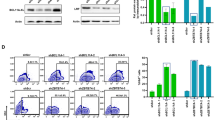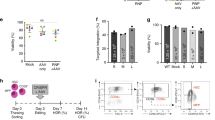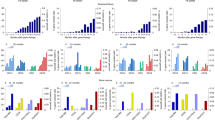Abstract
Gene therapy has been proposed as a potential treatment for Wiskott–Aldrich syndrome (WAS), a severe primary immune deficiency characterized by multiple hematopoietic-specific cellular defects. In order to develop an optimal lentiviral gene transfer cassette for this application, we compared the performance of several internal promoters in a variety of cell lineages from human WAS patients. Vectors using endogenous promoters derived from short (0.5 kb) or long (1.6 kb) 5′ flanking sequences of the WAS gene, expressed the transgene in T, B, dendritic cells as well as CD34+ progenitor cells, but functioned poorly in non-hematopoietic cells. Defects of T-cell proliferation and interleukin-2 production, and the cytoskeletal anomalies in WAS dendritic cells were also corrected. The levels of reconstitution were comparable to those obtained following transduction with similar lentiviral vectors incorporating constitutive PGK-1, EF1-alpha promoters or the spleen focus forming virus gammaretroviral LTR. Thus, native regulatory sequences target the expression of the therapeutic WAS transgene to the hematopoietic system, as is naturally the case for WAS, and are effective for correction of multiple cellular defects. These vectors may have significant advantages for clinical application in terms of natural gene regulation, and reduction in the potential for adverse mutagenic events.
This is a preview of subscription content, access via your institution
Access options
Subscribe to this journal
Receive 12 print issues and online access
$259.00 per year
only $21.58 per issue
Buy this article
- Purchase on Springer Link
- Instant access to full article PDF
Prices may be subject to local taxes which are calculated during checkout







Similar content being viewed by others
References
Ochs HD, Thrasher AJ . The Wiskott–Aldrich Syndrome. J Allergy Clin Immunol 2006; 117: 725–738.
Badour K, Zhang J, Siminovitch KA . The Wiskott–Aldrich syndrome protein: forging the link between actin and cell activation. Immunol Rev 2003; 192: 98–112.
Burns S, Cory GO, Vainchenker W, Thrasher AJ . Mechanisms of WASp-mediated hematologic and immunologic disease. Blood 2004; 104: 3454–3462.
Sasahara Y, Rachid R, Byrne MJ, de la Fuente MA, Abraham RT, Ramesh N et al. Mechanism of recruitment of WASP to the immunological synapse and of its activation following TCR ligation. Mol Cell 2002; 10: 1269–1281.
Dupre L, Aiuti A, Trifari S, Martino S, Saracco P, Bordignon C et al. Wiskott–Aldrich syndrome protein regulates lipid raft dynamics during immunological synapse formation. Immunity 2002; 17: 157–166.
Jones GE, Zicha D, Dunn GA, Blundell M, Thrasher A . Restoration of podosomes and chemotaxis in Wiskott–Aldrich syndrome macrophages following induced expression of WASp. Int J Biochem Cell Biol 2002; 34: 806–815.
Calle Y, Jones GE, Jagger C, Fuller K, Blundell MP, Chow J et al. WASp deficiency in mice results in failure to form osteoclast sealing zones and defects in bone resorption. Blood 2004; 103: 3552–3561.
Candotti F, Facchetti F, Blanzuoli L, Stewart DM, Nelson DL, Blaese RM . Retrovirus-mediated WASP gene transfer corrects defective actin polymerization in B cell lines from Wiskott–Aldrich syndrome patients carrying ‘null’ mutations. Gene Therapy 1999; 6: 1170–1174.
Wada T, Jagadeesh GJ, Nelson DL, Candotti F . Retrovirus-mediated WASP gene transfer corrects Wiskott–Aldrich syndrome T-cell dysfunction. Hum Gene Ther 2002; 13: 1039–1046.
Klein C, Nguyen D, Liu CH, Mizoguchi A, Bhan AK, Miki H et al. Gene therapy for Wiskott–Aldrich syndrome: rescue of T-cell signaling and amelioration of colitis upon transplantation of retrovirally transduced hematopoietic stem cells in mice. Blood 2003; 101: 2159–2166.
Strom TS, Gabbard W, Kelly PF, Cunningham JM, Nienhuis AW . Functional correction of T cells derived from patients with the Wiskott–Aldrich syndrome (WAS) by transduction with an oncoretroviral vector encoding the WAS protein. Gene Therapy 2003; 10: 803–809.
Dupre L, Trifari S, Follenzi A, Marangoni F, Lain de Lera T, Bernad A et al. Lentiviral vector-mediated gene transfer in T cells from Wiskott–Aldrich syndrome patients leads to functional correction. Mol Ther 2004; 10: 903–915.
Charrier S, Stockholm D, Seye K, Opolon P, Taveau M, Gross DA et al. A lentiviral vector encoding the human Wiskott–Aldrich syndrome protein corrects immune and cytoskeletal defects in WASP knockout mice. Gene Therapy 2005; 12: 597–606.
Martin F, Toscano MG, Blundell M, Frecha C, Srivastava GK, Santamaria M et al. Lentiviral vectors transcriptionally targeted to hematopoietic cells by WASP gene proximal promoter sequences. Gene Therapy 2005; 12: 715–723.
Dupre L, Marangoni F, Scaramuzza S, Trifari S, Hernandez RJ, Aiuti A et al. Efficacy of gene therapy for Wiskott–Aldrich syndrome using a WAS Promoter/cDNA-containing lentiviral vector and nonlethal irradiation. Hum Gene Ther 2006; 17: 303–313.
Salmon P, Kindler V, Ducrey O, Chapuis B, Zubler RH, Trono D . High-level transgene expression in human hematopoietic progenitors and differentiated blood lineages after transduction with improved lentiviral vectors. Blood 2000; 96: 3392–3398.
Demaison C, Parsley K, Brouns G, Scherr M, Battmer K, Kinnon C et al. High-level transduction and gene expression in hematopoietic repopulating cells using a human immunodeficiency [correction of imunodeficiency] virus type 1-based lentiviral vector containing an internal spleen focus forming virus promoter. Hum Gene Ther 2002; 13: 803–813.
Olivier A, Jeanson-Leh L, Bouma G, Compagno D, Blondeau J, Seye K et al. A partial down-regulation of WASP is sufficient to inhibit podosome formation in dendritic cells. Mol Ther 2006; 13: 729–737.
Dull T, Zufferey R, Kelly M, Mandel RJ, Nguyen M, Trono D et al. A third-generation lentivirus vector with a conditional packaging system. J Virol 1998; 72: 8463–8471.
Thrasher AJ . WASp in immune-system organization and function. Nat Rev Immunol 2002; 2: 635–646.
Calle Y, Chou HC, Thrasher AJ, Jones GE . Wiskott–Aldrich syndrome protein and the cytoskeletal dynamics of dendritic cells. J Pathol 2004; 204: 460–469.
Linder S, Wintergerst U, Bender-Gotze C, Schwarz K, Pannicke U, Aepfelbacher M . Macrophages of patients with X-linked thrombocytopenia display an attenuated Wiskott–Aldrich syndrome phenotype. Immunol Cell Biol 2003; 81: 130–136.
Breckpot K, Corthals J, Heirman C, Bonehill A, Michiels A, Tuyaerts S et al. Activation of monocytes via the CD14 receptor leads to the enhanced lentiviral transduction of immature dendritic cells. Hum Gene Ther 2004; 15: 562–573.
Hagemann TL, Kwan SP . The identification and characterization of two promoters and the complete genomic sequence for the Wiskott–Aldrich syndrome gene. Biochem Biophys Res Commun 1999; 256: 104–109.
Petrella A, Doti I, Agosti V, Giarrusso PC, Vitale D, Bond HM et al. A 5′ regulatory sequence containing two Ets motifs controls the expression of the Wiskott–Aldrich syndrome protein (WASP) gene in human hematopoietic cells. Blood 1998; 91: 4554–4560.
Sandelin A, Alkema W, Engstrom P, Wasserman WW, Lenhard B . JASPAR: an open-access database for eukaryotic transcription factor binding profiles. Nucleic Acids Res 2004; 32: D91–D94.
Lenhard B, Wasserman WW . TFBS: computational framework for transcription factor binding site analysis. Bioinformatics 2002; 18: 1135–1136.
Strom TS, Turner SJ, Andreansky S, Liu H, Doherty PC, Srivastava DK et al. Defects in T-cell-mediated immunity to influenza virus in murine Wiskott–Aldrich syndrome are corrected by oncoretroviral vector-mediated gene transfer into repopulating hematopoietic cells. Blood 2003; 102: 3108–3116.
Uchida N, Sutton RE, Friera AM, He D, Reitsma MJ, Chang WC et al. HIV, but not murine leukemia virus, vectors mediate high efficiency gene transfer into freshly isolated G0/G1 human hematopoietic stem cells. Proc Natl Acad Sci USA 1998; 95: 11939–11944.
Mostoslavsky G, Kotton DN, Fabian AJ, Gray JT, Lee JS, Mulligan RC . Efficiency of transduction of highly purified murine hematopoietic stem cells by lentiviral and oncoretroviral vectors under conditions of minimal in vitro manipulation. Mol Ther 2005; 11: 932–940.
De Palma M, Montini E, de Sio FR, Benedicenti F, Gentile A, Medico E et al. Promoter trapping reveals significant differences in integration site selection between MLV and HIV vectors in primary hematopoietic cells. Blood 2005; 105: 2307–2315.
Montini E, Cesana D, Schmidt M, Sanvito F, Ponzoni M, Bartholomae C et al. Hematopoietic stem cell gene transfer in a tumor-prone mouse model uncovers low genotoxicity of lentiviral vector integration. Nat Biotechnol 2006; 24: 687–696.
Towers GJ, Stockholm D, Labrousse-Najburg V, Carlier F, Danos O, Pages JC . One step screening of retroviral producer clones by real time quantitative PCR. J Gene Med 1999; 1: 352–359.
Aiuti A, Friedrich C, Sieff CA, Gutierrez-Ramos JC . Identification of distinct elements of the stromal microenvironment that control human hematopoietic stem/progenitor cell growth and differentiation. Exp Hematol 1998; 26: 143–157.
Acknowledgements
We thank the patients and their families. We are grateful to A Fischer, C Picard, B Varet (Hôpital Necker, Paris), R Favier (Hôpital Trousseau, Paris) and S Martino (Department of Pediatrics, Turin University) for providing WAS patient samples. We are thankful to Genethon collaborators, in particular to G Griffith, S Martin, S Bucher, S Potier, A Jollet, K Seye and J Blondeau for help with vector construction, production and transduction experiments, to T Larmonier for establishment and maintenance of patient B-LCL lines. Special thanks to D Stockholm for help with image acquisition and analysis. We are grateful to S Tsuchyia (Tohoku University, Sendai, Japan) for providing the 5A5 anti-WASP mAbs and to L Naldini (Tiget, Milan, Italy) for providing the pRRL vector system. This work was supported by equipment funds from ‘Génopole Recherche’, Evry, France, by grants from the AFM (French Muscular Dystrophy Association, Evry, France) and Italian Telethon (to MGR, LD), from the EU CONSERT integrated project (FP6-Project No. 005242), the Wellcome Trust (AJT) and EU STREP EURO-POLICY PID (FP6 Project No. SP23-CT-2005-006411, MPB).
Author information
Authors and Affiliations
Corresponding author
Additional information
Supplementary Information accompanies the paper on Gene Therapy website (http://www.nature.com/gt).
Supplementary information
Rights and permissions
About this article
Cite this article
Charrier, S., Dupré, L., Scaramuzza, S. et al. Lentiviral vectors targeting WASp expression to hematopoietic cells, efficiently transduce and correct cells from WAS patients. Gene Ther 14, 415–428 (2007). https://doi.org/10.1038/sj.gt.3302863
Received:
Revised:
Accepted:
Published:
Issue Date:
DOI: https://doi.org/10.1038/sj.gt.3302863
Keywords
This article is cited by
-
Genetic abrogation of immune checkpoints in antigen-specific cytotoxic T-lymphocyte as a potential alternative to blockade immunotherapy
Scientific Reports (2018)
-
Biological and functional characterization of bone marrow-derived mesenchymal stromal cells from patients affected by primary immunodeficiency
Scientific Reports (2017)
-
Optimization of methods for the genetic modification of human T cells
Immunology & Cell Biology (2015)
-
Generation of a lentiviral vector producer cell clone for human Wiskott-Aldrich syndrome gene therapy
Molecular Therapy - Methods & Clinical Development (2015)
-
Lentiviral vectors for the treatment of primary immunodeficiencies
Journal of Inherited Metabolic Disease (2014)



